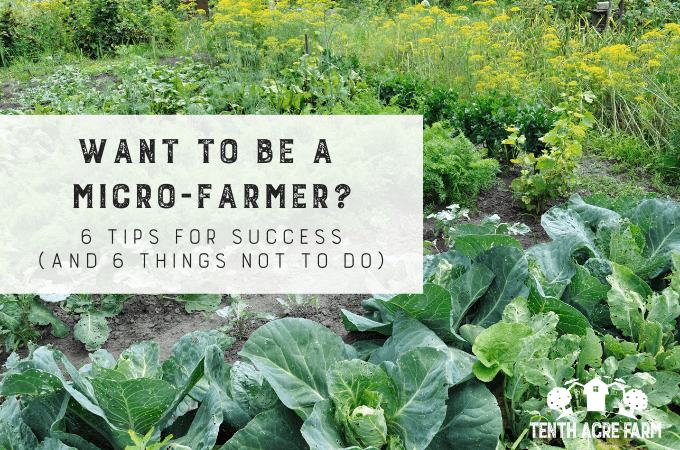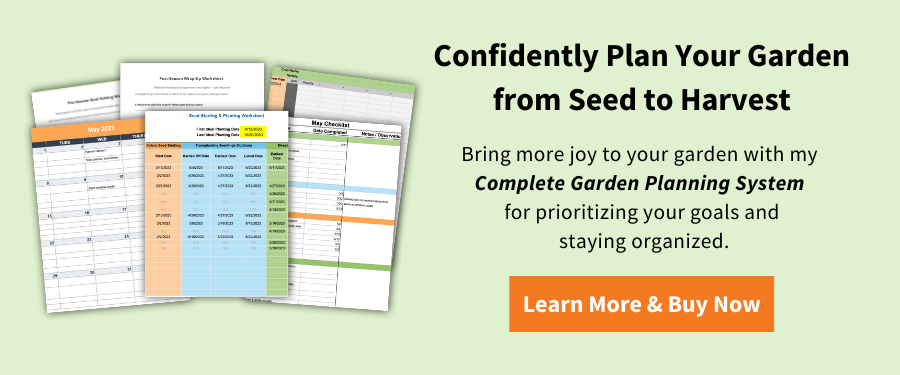Want to Be a Micro-Farmer? 6 Tips for Success
Would you like to grow food for your family, but don’t know how to start? Here are 6 mistakes the new micro-farmer makes and 6 ways to ensure your success.


This page may contain affiliate links. Please read my disclosure for more info.
Six Mistakes NOT to Make (Or The New Micro-Farmer’s Commandments)
As a new gardener, you’re all starry-eyed with visions of beautiful, productive gardens, right? The thing is, starting off on the wrong foot could make you loathe gardening, and that’s NOT what you want. It shouldn’t feel like a chore. Tending to your backyard micro-farm should be fun!
Here are a few things NOT to do:
- Thou shalt not plant a GIANT garden your first year. Unless your goal is failure, then be my guest.
- Thou shalt not overestimate how much time you have to dedicate to a garden. Will you *really* be available every evening and every weekend?
- Thou shalt not plant all the vegetables your family *should* be eating. “No one’s getting up from this table until all of this (slimy, cooked) spinach is gone!”
- Thou shalt not assume you can learn All-The-Skills right off the bat. Unless you’ve mastered other unbelievable feats like learning how to play the guitar overnight or climbing Mt. Everest without training.
- Thou shalt not go overboard with the vegetable crops (ignoring other types of crops).
- Thou shalt not claim to be a natural plant killer. 🙂
So now that we’ve got those covered, let’s talk about what you SHOULD be doing. The following tips will ensure that you’re the reigning micro-farmer over your own super-successful, productive, and enjoyable micro-farm.
Six Tips to Be a Successful Micro-Farmer
1. Start small.
Many of us tend to go all in when we’re starting something new. Ready to get in shape (again)? We’ll buy new workout clothes, new shoes, the latest activity tracker, and gym membership. When we lose steam, we feel like big failures. We’re left with a credit card bill and the recurring costs of those programs reminding us of our bad decision.
A wise man once said, “The secret to happiness is low expectations.” —Barry Schwartz.
See, the mistake wasn’t that you wanted to get in shape. The mistake was that you set the bar too high. There are going to be days when the kids need chauffeured to kingdom come and back, and days when you can’t get out of the office before dark.
Low expectations mean you can be successful every day, no matter what. What if your expectation was to do 15 minutes of focused exercise a day? Speed-walk around the parking lot while waiting for your kid’s soccer practice to get over, or stay at the office an extra 15 minutes and run up and down the stairs. Low expectations and high flexibility (creativity) means success.
The same goes for the garden. This should be fun and rewarding! Rather than till up your whole yard in the first year (high expectations), start with one raised bed, a collection of pots on your patio, or plant a low-maintenance kitchen herb garden. Trade in those high expectations for that high creativity.
You can always scale up as your success and enthusiasm grow.
Grow a garden that’s both productive and manageable with my Complete Garden Planning System, which includes practical tools for planning your season from seed to harvest.


2. Commit to 15 minutes a day.
It’s true that the more time you commit to doing something, the more you get out of it. But it’s also true that if you feel completely overwhelmed, you might not even start. The 15-minutes-a-day gardening strategy empowers you to get out there and do something every day, even if you don’t finish it all.
Plus, it’s 15 minutes of non-negotiable time you get to spend on yourself. You’re getting outside, breathing fresh air, observing the daily changes of a garden, and you get the satisfaction of sticking to your goals. For some extra fun, take your 15 minutes with your morning coffee or with your favorite after-work happy hour drink. The more enjoyable it is, the more you’ll stick with it!
And hey: You can always scale up. Do you have the 15 minutes down pat? I see your 15 minutes and raise you 30!
Need more tips for preventing overwhelm? See my article 7 Ways to Start a Homestead (Without Being Overwhelmed).
3. Plant what you love to eat.
Do you have visions of forcing the whole family to sit at the dinner table until they’ve eaten the broccoli you worked so hard to grow? Save yourself the agony and make a list of the fruits and vegetables that your family loves.
From that list, figure out what grows in your climate AND GROW THAT. You can force your family to expand their palate in the future, but for now, go for the easy wins.
4. Farm out the work.
You *could* start out in the spring by sowing seeds, keeping them carefully watered (but not too moist), and thinning the delicate seedlings as they grow. Or, you *could* acquire a bunch of equipment and start your own seedlings indoors under grow lights.
Do you know what both of these scenarios have in common? They both require some measure of experience, as well as extra time to raise your plants from birth.
If you’re just starting out, give yourself a leg up. Skip the infant stage and instead adopt seedlings from the farmers’ market or local plant nursery. If you’re wondering why, see the 4th New Micro-Farmer’s Commandment above.
(Experienced gardeners: See my step-by-step guide to starting seeds indoors.)
Would you like to grow more food with less effort? Check out my mini guide, The Permaculture Inspired Vegetable Garden.
5. Grow Perennials.
As new gardeners, we can sometimes have blinders on when it comes to our garden. All we see are vegetables. And we tend to go overboard. We plant tomatoes in the garden, in pots on the patio, and in the front yard landscaping. I encourage, no—implore—you to expand your horizons for your own benefit.
Annual vegetables are a lot of work. And it’s unnecessary to give ourselves so much work, when there are so many low-maintenance crops that can help us feel successful without being overwhelmed.
Give perennials a chance.
Perennials are those plants that come back year after year, producing delicious food without much work on your part. Some examples are asparagus, fruit and nut trees, berry bushes, strawberries, and herbs. If a low-maintenance garden is your top priority, perennials are your friend.


6. Don’t give in to the ‘green thumb’ myth.
The term ‘green thumb’ implies that one has a natural skill for growing things. Unfortunately, it also implies that you can’t become a green thumb; that you either have this innate ability or you don’t. However, this couldn’t be further from the truth.
If you’ve had a gardening failure (which is every gardener, ever), you may be tempted to chalk it up to the color of your thumb and call it quits.
But I humbly request that you don’t throw in the towel just yet. The key to becoming an expert at something is simply a matter of practicing a task, again and again. This is how you gain confidence and improve over time.
You wouldn’t expect to be able to play the guitar after one lesson, would you?
Instead, bust through failure and doubt by becoming a detective and making observations about what happened: Did your cucumbers succumb to a disease or pest?
- What were the symptoms?
- What could you try next time?
Google is your friend! Search for clues, like those found in my article Grow the Best Cucumbers with These 12 Steps.
And remember:
One of the worst mistakes you can make as a gardener is to think you’re in charge.” ~ Janet Gillespie, author of The Joy of a Small Garden
Summary
When you start with low expectations, plant what you love, get help, plant low maintenance crops, and approach gardening with the curiosity of a scientist, you’ll be well on your way to becoming a successful micro-farmer, and you’ll have fun doing it.
Were you a beginning micro-farmer once? What helped you get through the beginner phase?
READ NEXT:









